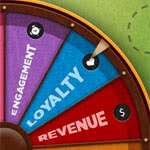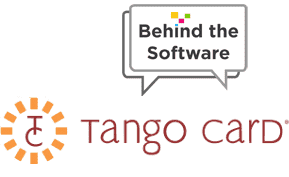Gamification
Social CRM
Behind the Software Q&A with BigDoor VP of Sales

Is gamification a fleeting trend or a lasting CRM innovation? Companies of all shapes and sizes are taking the method of increasing customer engagement to heart, and gamification providers are looking to make the practice a critical part of building customer relationships. Seattle-based BigDoor may be one of the leaders in the gamification field, but they want to make it clear that they’re not just another gamification vendor. Rather, they focus on building loyalty and engagement in a meaningful way. VP of Sales Gavin Hewitt talked to us recently about what sets BigDoor apart from the competition, and how the company plans to grow in 2013.
To start, tell us a little bit about BigDoor. What was the inspiration behind BigDoor when you first got started?
BigDoor was founded in 2009 with the initial goal of making the internet more fun, even prior to the term gamification being created. At a really high level, we power gamified loyalty and rewards programs for large brands. We work with over 300 partners, including Major League Baseball, Yamaha, Adobe and Microsoft. There are a bunch of others that we don’t typically talk about because we want what we develop for our partners to feel on-brand and in those cases we’re not trying to be the central focus. We want it to feel very authentic and like it’s actually coming from the brands that we work with.
A lot of gamification to date has been focused on employee engagement. Our focus is consumer-facing, points-based loyalty and rewards programs that leverage gamification concepts to enhance loyalty and engagement. I like to say that we bridge the gap between traditional points-based loyalty and gamification, whereby we actually provide the rewards and points associated with traditional loyalty, but we also have the engagement layer with gamification. Really, the goal for any Bigdoor program is to increase acquisition; getting folks to register. Next is increasing their engagement; any action that is viewed as revenue generating for our customers, we want to make sure that people are doing more of, and then, finally, retention, increasing that brand loyalty and getting people to come back over and over and over again.
You said that one of the things that sets BigDoor apart is that you focus on providing a white label solution to gamification. What else sets you apart from some of the other companies that are in this niche? Because it’s not a huge industry, but it’s definitely a growing one, right?
It is. And I think oftentimes we get lumped in with what people call the “Bs.” I’ve often heard people ask, “How do you compare yourself with the other Bs?” meaning Badgeville and Bunchball. We really view ourselves as a company that uses gamification, but we’re not a gamification vendor. We’ve found through testing with over 70 million active users that simply adding badges and leaderboards and points doesn’t have a long-term impact on behavior. That impact is typically very short if it’s not in conjunction with a rewards program where people can actually use those points to get access to something. Much like you would never join an airline program that just gave you badges and leaderboards, you need that points-based rewards program to keep you coming back and loyal. We like to marry the two of those. That’s a huge differentiator for us.
The other piece is that on the front end we act very much like a design agency to create a very custom on-brand experience. We aren’t simply a plug-and-play mechanism. Our technology is very simple to implement, but on the front end we help to build an experience that’s going create that long-term engagement and feel very authentic.
Another piece that I think sets us apart is that we provide ongoing program management. So once we’ve built the economy and we’ve built some of the quests, badges and the design creative, we assign an account management team that will help update key content and quests. We want to make sure that we’re continuing to engage with those consumers in new and exciting ways that really keep them coming back and engaging with the brands we work with.
BigDoor is not strictly a gamification vendor, but it seems like gamification would go hand-in-hand with a customer relationship management software. Say I use Salesforce and I want to integrate BigDoor’s services into my large-scale plan. Is that something you can facilitate?
There are two sides to that. The first is that with every implementation, we enable something called a single sign on. Whatever a brand’s user authentication system is, we’re going to tap into that. When people are registering for the rewards program they’re also registering with the brand, so that’s going to automatically populate their CRM system. And as we begin to learn more about these folks we can add more profile information that will feed into their CRM. Companies are better informed and able to do real relationship marketing as well as any personalization initiatives that they may have. So we’re building that out for our customers in every implementation that we do currently.
The second piece of that is that some of the CRM systems also support very traditional points-based loyalty programs, often dollar-backed currency, which, again, is another distinction. Our platform is a non-dollar-backed currency. But we are happy to tie into some of those existing traditional loyalty platforms. We are happy to be the engagement layer addition to an existing loyalty system that’s maybe been in place for years.
Mobile optimization, as I’m sure you know, is increasingly important these days with the growing popularity of tablets and smart phones. How has BigDoor responded to that kind of growth? Is there anything you’ve had to do differently to accommodate the popularity of people browsing on mobile devices?
Yes, we absolutely can do mobile and mobile-enabled web (MDOT, native app, tablet). For some of our customers we also are using responsive design, so the way our implementation looks and feels, no matter what device they’re on, is going to be responsive. From a strategy perspective, we think that one of the most important things that we’re accomplishing for our customers is allowing them to know who people are on various devices. Before if a visitor went to MLB’s website from their mobile device, tablet, and PC, MLB thought they were three different people. Now that they have a solid rewards and a gamified loyalty platform, they give people a reason every single time they engage with the brand to actually log in. And when they log in, companies now know who they are. From a CRM perspective, you can begin to personalize customers experiences as a result of knowing who they are on these various devices. So no longer are visitors three different people depending on device; I really think it connect the dots for a bunch of the brands we work with.
What are the biggest challenges that you’re anticipating in 2013?
That’s a great question. I think that there are things we’ve definitely been talking about in terms of what we see for the future. I think what we worry about most are gamification implementations that are not on-brand and that don’t feel authentic, that feel kind of tacked on and not really natural for the consumer. The reality is that there are a lot of poor implementations out there that will simply fail, and that’s something that we continue to worry about day in and day out and it’s why we choose to go about business the way that we do.
On the positive side, what’s something that you’re looking forward to next year? Any new features that we should look out for, or anything that your customers or potential customers might be excited to hear about?
Absolutely. The first is this notion of tying into existing traditional points-based loyalty programs. I think loyalty programs are going to be stepped up in 2013 with the help of adding the engagement layer of gamification. We’re super focused on the consumer, I really can’t harp on that enough. We’re not interested in the inside the walls of an organization implementation and think that consumer facing loyalty is the place to be in 2013. I think that we’ll continue to be cross-device and cross-platform with the ability to identify who these folks are across platforms.
We’re also really excited about ecommerce and retail. We think that will be the fastest growing vertical for gamified loyalty in 2013. Hopefully we will also see advertisers embracing gamification sometime soon as a new growth area for them to get into. The notion of tying into people’s CRM data and using gamification and gamified loyalty programs to really drive more personalization and better user experiences is going to be something that we’re going to see more of.
From an analytics perspective we’re going to continue to drive more and better analytics and gamification and loyalty program companies that don’t have the analytics to support what they’re doing are going to fail, and so we continue to focus on that. How do you know if something’s successful if you’re not measuring it properly?
That’s quite a list of things that we should keep our eyes peeled for! Is there anything else that our readers should know about BigDoor?
I think in the end, for any business, especially a business who is trying to implement some type of points-based loyalty and gamification strategy in 2013, is this idea that they don’t have to be mutually exclusive. Bringing the two together along with the ability to drive user acquisition, engagement and retention is a recipe for success. We’re seeing it work for all of our customers and we relish the opportunity to prove that time and time again.
Want to learn more about BigDoor and other gamification software? Search our software product directory to browse our entire catalogue of software for gamification and social CRM needs.






